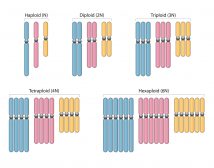A spermatozoon or an ovum.
You will also like...

Genetic Information and Protein Synthesis
Genes are expressed through the process of protein synthesis. This elaborate tutorial provides an in-depth review of the different steps of the biological production of protein starting from the gene up to the process of secretion. Also included are topics on DNA replication during interphase of the cell cycle, DNA mutation and repair mechanisms, gene pool, modification, and diseases...

Human Reproduction
Humans are capable of only one mode of reproduction, i.e. sexual reproduction. Haploid sex cells (gametes) are produced so that at fertilization a diploid zygote forms. This tutorial is an in-depth study guide regarding male and female reproductive physiology...

Polyploidy
Humans are diploid creatures. This means that for every chromosome in the body, there is another one to match it. However, there are organisms that have more than two sets of chromosomes. The condition is called polyploidy. Know more about this topic through this tutorial...

Plant Biology
Plantlife can be studied at a variety of levels, from the molecular, genetic and biochemical level through organelles, cells, tissues, organs, individuals, plant populations, and communities of plants. These tutorials will help you learn and appreciate plants regarding their distinctive structures and remarkable inherent strategies for thriving and survival. ..

Leaves
Leaves are the major photosynthetic organ of a plant. Apart from that, they are also crucial to water movement. In this tutorial, various plant processes are considered in more detail. It also includes topics on leaf arrangements, leaf types, leaf structure, leaf color, abscission, and importance to humans...

Bryophytes
Bryophytes (nonvascular plants) are a plant group characterized by lacking vascular tissues. They include the mosses, the liverworts, and the hornworts. These groups of plants require external water, usually in the form of dew or rain. Some of them grow exclusively in dark, damp environments in order to provide moisture. Find out more about them here...
